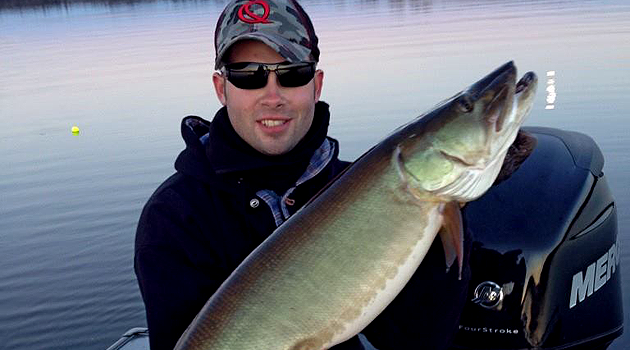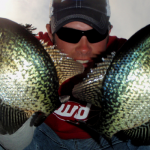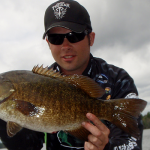By Andrew Ragas
Each November a phenomenon occurs in some our, deep, clear and colder Northern waters. If you don’t fish for muskies or any meaningful trophy fish this late in the season, you may think it involves winterizing the boat or preparing for first ice. However, if you understand the forage complexions and underwater ecosystems of these lakes, you may figure out that the annual cisco and whitefish spawns take place.
This year I’ve had the opportunity to fish deeper into the season than ever before. I’ve also been able to reach my ‘unplanned’ goal, and set the personal milestone of fishing for 100 days up north in 2013.
I always call it quits with the up north travels by mid October and get burned out with fishing entirely shortly after. But not this year, and likely never again. Thanks to my good friend and tournament partner Steve Peterson and his dad Bob (and Steve’s father in-law Ray), I’ve been able to join my musky pals for these long weekend trips which have been a blast. It only took me all 27 years of life to realize that no matter how cold the weather may be, how obsessed and crazy of anglers we are, and how almost frozen the lakes and their boat landings will be, November can be a magical month for muskies and more.
Hey Steve, remember that one weekend in mid November we broke ice in order to catch big fish?

Below the cold water’s surface, toothy predators such as musky, pike, and walleye feed voraciously as the urgency of winter looms closer. They target whatever forage concentrations are available. This time of year, it’s ciscoes on the deep oligotrophic and mesotrophic lakes, and sometimes schooling suckers. The larger the concentrations of these forage species, the larger the concentration of these apex predators can be. In mid to late November, the cisco spawn is certainly the largest and most predictable forage concentration around, and is easily the best trophy game in town.

Staging ciscos were registered on the HDS during the morning hours. As soon as darkness sets, these baitfish can be found spawning along gravel and sand shorelines as shallow as 2 feet deep.
Ciscoes inhabit natural lakes and reservoirs of moderate to low fertility. Historically, they only inhabited larger lakes, but naturally reproducing populations have been successfully established as an additional forage supply in lakes as small as 200 acres providing they have depth and adequate spawning habitat. High water clarity is not necessary for their survival. But for ciscoes to thrive and populate, high water quality is required. In Wisconsin, cisco grow no longer than 5 to 10 inches, and will spawn in 38 to 40 degree waters under the moon-lit darkness.
Throughout our weekend trips the best fishing often took place by working closely near the forage concentrations: Remaining deep weed edges, cisco spawning flats, steep shorelines and deep breaklines. Presentations that could be fished slowly and suspend in the water column often fared best. Gliders such as Softail Phantoms, crankbaits including Kraves, Cisco Kids, Depth Raiders and Magnum Rapalas, and the up north tradition of running multiple quick-strike sucker rigs at varying depths and perimeters around the boat produced all of our fish.
Besides following these presentations, time of day was certainly a factor as well. Playing the moon game, fishing the most productive spots in afternoons and evenings, and staying on the water well past sunset were all critical concepts leading to our success. Feeding windows were undoubtedly short, but the flurry of action that came within these windows were almost always comprised of multiple feeding fish. Following these patterns over the course of two long November weekends, twelve muskies and other big bonus species slimed the Frabill and provided us with ample amounts of late season fish porn to keep us satisfied throughout the upcoming winter months.




At this time, muskies, pike, and walleyes of all sizes feed on these schools and become as catchable as they ever will be. This does not mean the fishing is super easy, but it becomes substantially easier. The joy of fishing during the midst of the cisco spawn is that the same presentations usually work great for all three species.
For instance, never underestimate the the size of lure a huge cisco feeding walleye will strike. This big one, my largest ever from Wisconsin waters, took down a 9 inch Cisco Kid crankbait.

Fishing during the month of November isn’t for the frail, impatient, or intolerant of the cold. It’s a time for diehards and the possessed to feast on end of season opportunities and concluding feeding splurges of Esox Masquinonge. Fishing the cisco spawn similarly to how we did is simply a matter of timing and putting all the pieces together even if much of it came through the assistance of guides, friends and our independent research. The correct locations, water temperatures, and presentations are all a necessity for successful fishing to take place. Once these variables are put together in proper fashion, it usually doesn’t take long for good things to happen.
As I keep getting older, I see more and more how the month of November is some of the best fishing of the year. In 2014 I may need to put less emphasis on my annual October trip and focus more on November up north, no matter how cold it gets!
During this time of year, prior to first ice and the dreaded freeze, all you can do is cast your Hail Marys because the big bite is bound to happen. And when time runs out like it did for us, all good things must come to an end.

Editors Note:: During the closing moments of our last day of fishing for the year, a four foot, 30 pound monster hammered one of the three quick-strike rigged suckers I was operating in the boat’s rear. When fish ran away from the boat I set the hook and I was in for a battle. The stiff, 7 foot graphite rod quickly became an adult version snoopy rod and I really had no chance of winning this battle. As the fish quickly drew near boatside, Bob reached for it with the net and as fish was turned head-first, she shook the hooks before making contact with the bag and back at me flew my unscathed sucker rig. Due to the frail rod we had on deck apparently I never drove home the hooks with my gargantuan hook-set. The entire fish was observed; head was huge, jaws could fit an entire 20 inch sucker, torso was immense, and length was greater than the 46 inch replica that was hanging on Bob’s wall. Was it the fabled 50 incher? I don’t think so, but it was big, had weight, and made the above mid forty look like a minnow. I hadn’t lost a single big fish of any species in 2013 until that moment. Better later than never I guess. On the bright side, I’m not sure this fish could have been handled any better than we did, and to do all of that with a more cursed and crappier rod was quite an achievement. As it was in this case, musky fishing became a game of inches and as mentioned above, we ran out of time. If only I had two more seconds to dance with that fish while she was in the water, she would have been in the net. I only wanted to get my photograph. But the memory was caught, and that’s all she ever will be.







